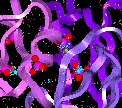 Forcefields Supported by
the Discover Program
Forcefields Supported by
the Discover Program Forcefields Supported by
the Discover Program
Forcefields Supported by
the Discover ProgramThe CVFF (consistent valence forcefield) forcefield was parameterized to reproduce peptide and protein properties. It is a Class I forcefield having some anharmonic and cross term enhancements. As the default forcefield in the Discover program, it has been used extensively on these systems and can be considered well tested and characterized.
The CFF91 (consistent forcefield) forcefield is a second-generation, or Class II, forcefield (Maple et al. 1988, 1994, in press, Dinur and Hagler 1991, Waldman and Hagler 1993, Hill and Sauer 1994, Hwang et al. in press, Hagler and Ewig in press, Sun et al. in press). It was parameterized against a wide range of experimental observables and has been shown to be more accurate than Class I forcefields such as CVFF and AMBER. Because it is new, it has not been tested as extensively as the other two forcefields and thus is not as well characterized.
The ESFF (extensible systematic forcefield) forcefield is a new rule-based forcefield, which is currently under development. In contrast to other forcefields supported by Biosym/MSI, which target high accuracy for a limited number of functional groups, the goal of this forcefield is to provide the widest possible coverage of the periodic table. The objectives of the current efforts are twofold: to provide a usable forcefield covering organic and organometallic compounds and to provide a foundation for future compatible forcefield development. The immediate focus is to reproduce the structures of isolated molecules as well as crystals. Reasonable steps are being taken to also reproduce the shape of the potential energy surface (i.e., the vibrational frequencies), but the scope of the current effort does not extend to highly accurate vibrational frequencies or other properties such as conformational energies.
The AMBER forcefield (Weiner et al. 1984, 1986) was parameterized against a limited number of compounds related to proteins and nucleic acids. It is a quadratic diagonal Class I forcefield that has been cited frequently in the literature and may be considered well characterized. It has also been extended to polysaccharides (Homans 1990).
The ability to choose among several forcefields has several advantages:
 Main
access page
Main
access page  Theory/Methodology access.
Theory/Methodology access.
 Forcefields access
Forcefields access
 What Is a Forcefield?
What Is a Forcefield?
 Atom Type Assignment
Atom Type Assignment
Copyright Biosym/MSI